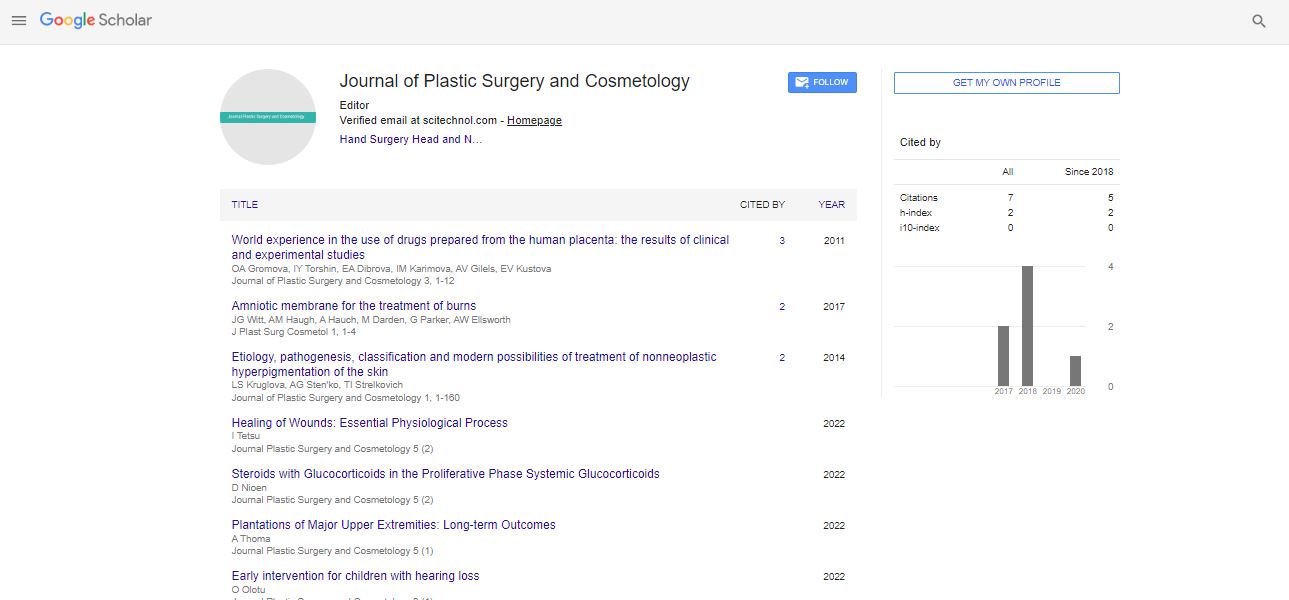Opinion Article, J Pls Sur Cos Vol: 12 Issue: 3
Innovations in Maxillofacial Surgery: Enhancing Care and Quality of Life
Leonel Richards*
1Department of Plastic Surgery, University of Helsinki, Helsinki, Finland
*Corresponding Author: Leonel Richards,
Department of Plastic Surgery,
University of Helsinki, Helsinki, Finland
E-mail: leonelrichards@gmail.com
Received date: 05 September, 2023, Manuscript No. JPSC-23-116719;
Editor assigned date: 07 September, 2023, PreQC No. JPSC-23-116719 (PQ);
Reviewed date: 21 September, 2023, QC No. JPSC-23-116719;
Revised date: 29 September, 2023, Manuscript No. JPSC-23-116719 (R);
Published date: 06 October, 2023 DOI: 10.4172/JPSC.100060.
Citation: Richards L (2023) Innovations in Maxillofacial Surgery: Enhancing Care and Quality of Life. J Pls Sur Cos 12:3.
Description
Maxillofacial surgery often referred to as Oral and Maxillofacial Surgery (OMS), is a unique medical specialty that bridges the gap between medicine and dentistry. It encompasses a wide spectrum of conditions, from congenital anomalies to acquired injuries and complex facial reconstructions. Maxillofacial surgeons are experts in addressing facial and jaw disorders, making a significant impact on both appearance and function. The maxillofacial surgery can be traced back to ancient civilizations, where rudimentary surgical interventions for facial injuries and deformities were documented. However, the formal recognition of maxillofacial surgery as a specialized discipline began in the 19th century. Surgeons, particularly during wartime, contributed to the development of surgical techniques and approaches, laying the foundation for the comprehensive field that exists today.
Common maxillofacial procedures
Maxillofacial surgeons are skilled in a wide array of procedures. Some of the most common include:
Orthognathic surgery: Orthognathic surgery corrects discrepancies in jaw alignment and facial structure, often addressing conditions like overbites, underbites, and facial asymmetry.
Facial trauma reconstruction: Maxillofacial surgeons are integral in reconstructing facial injuries caused by accidents, falls, or assaults. Procedures include repairing fractures and soft tissue injuries.
Cleft lip and palate repair: Cleft lip and palate are congenital anomalies that require complex surgical repair to improve speech, feeding, and appearance.
Temporomandibular Joint (TMJ) surgery: TMJ disorders can cause pain, clicking, and limited jaw movement. Surgery may be necessary to alleviate these symptoms.
Dental implant surgery: Maxillofacial surgeons often perform dental implant surgery to replace missing teeth, enhancing both function and aesthetics.
Technological advancements
Maxillofacial surgery has been significantly transformed by technological innovations. These include:
Computer-aided surgical planning: Advanced software allows for precise planning and simulation of surgical procedures, improving accuracy and reducing surgical time.
3D printing: 3D printing technology has revolutionized the creation of custom implants, models, and guides, enhancing surgical precision.
Virtual Reality (VR) and Augmented Reality (AR): VR and AR technologies aid in preoperative planning and training, providing surgeons with immersive experiences.
Robotic surgery: Robot-assisted surgery offers increased precision and dexterity, especially in complex procedures such as tumor removal.
Interdisciplinary collaboration: Maxillofacial surgery often requires collaboration with a range of healthcare professionals, including dentists, orthodontists, otolaryngologists, and speech therapists. Interdisciplinary teams work together to ensure comprehensive care for patients, particularly those with complex facial conditions or those requiring orthodontic and speech rehabilitation.
Impact on quality of life: Maxillofacial surgery has a profound impact on the quality of life of patients. Beyond the restoration of physical function and aesthetics, it can alleviate pain, enhance speech, and boost self-esteem. Patients often report improved overall wellbeing and self-confidence after successful maxillofacial procedures.
Conclusion
Maxillofacial surgery, a unique and multidisciplinary field, plays a crucial role in the diagnosis, treatment, and rehabilitation of a wide range of conditions affecting the head, face, and neck. The historical evolution, common procedures, technological advancements, and interdisciplinary collaborations underscore the complexity and depth of this subspecialty. Through precision, innovation, and compassionate care, maxillofacial surgeons are dedicated to restoring function, enhancing aesthetics, and transforming the lives of their patients.
As the field continues to evolve and embrace technological advancements, it remains vital for practitioners to stay informed about the latest developments. Maxillofacial surgery will continue to provide solutions and improvements in the lives of patients, reaffirming its significance in the world of medicine and dentistry.
 Spanish
Spanish  Chinese
Chinese  Russian
Russian  German
German  French
French  Japanese
Japanese  Portuguese
Portuguese  Hindi
Hindi 